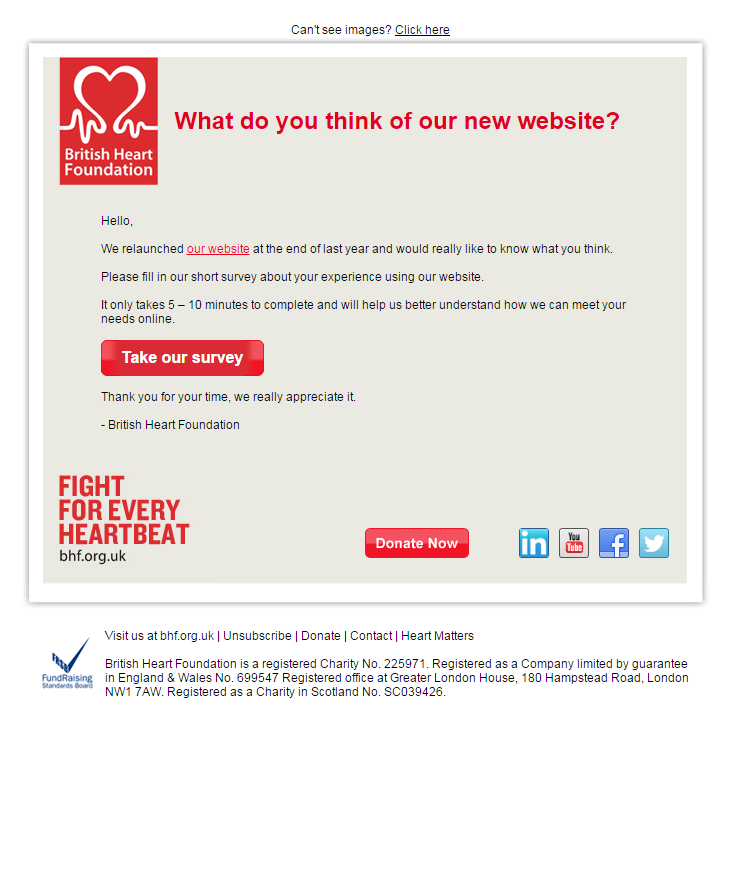Seven types of emails your non-profit should be sending
Email is still an effective way to get the word out about a fundraising campaign. But if you’re only emailing your subscribers to solicit donations, you’re doing it wrong.
Driving online donations isn’t your only goal, is it? As a non-profit you may have other objectives like keeping supporters informed, and attracting and retaining volunteers and donors.
That means you’ll need to create emails that can help you to achieve your other objectives as well. And you can only do that by engaging and building meaningful relationships with your supporters – whether they’re volunteers, sponsors, donors or partners – and show them that you don’t just care about them when you’re asking them for donations.
In this article we’ll walk you through seven types of emails that you should create and send to your mailing list.
But first: keep in mind that each type of email serves a specific purpose and should be sent to a specific audience. So, for best results, you should segment your list to make your campaigns relevant to each group of subscribers.
Ok, let’s get started.
1. Welcome email
Did you know that welcome emails have the highest open rate of any email you send to subscribers? Studies show that welcome emails have on average four times the open rate and five times the click-through rate of a standard email marketing campaign.
These stats aren’t so surprising when you consider that 74% of users expect a welcome email as soon as they subscribe. So, with this expectation, why not take advantage and make the most of this engagement? With email automation, you can simply trigger a welcome email each time someone signs up for your newsletter, fills out a contact form or makes a donation.
A welcome email should be short and sweet, assuring users that they’ve successfully joined your list or made a donation, while also starting a friendly conversation about your organisation, how you’re helping to make the world a better place and how they’re welcome to a valuable member.
Here’s an example from One Drop:
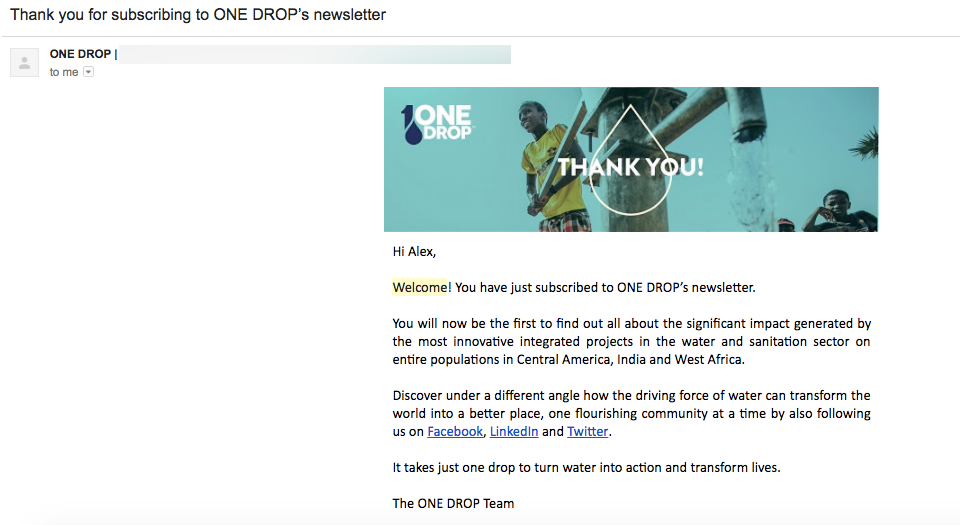
This email is simple and to the point, making it easy for subscribers to read it quickly. It greets them, explains what the organisation is about while also encouraging readers to connect with One Drop on social media.
While this is a good example, you might also consider including a few other things like:
- Two to three links to helpful resources so they can learn more about what you do and how they could get involved
- A powerful call-to-action, which needs to be present in every email campaign you send out.
Here’s another good example that’s clean and organised, outlining the steps a new subscriber should take next:
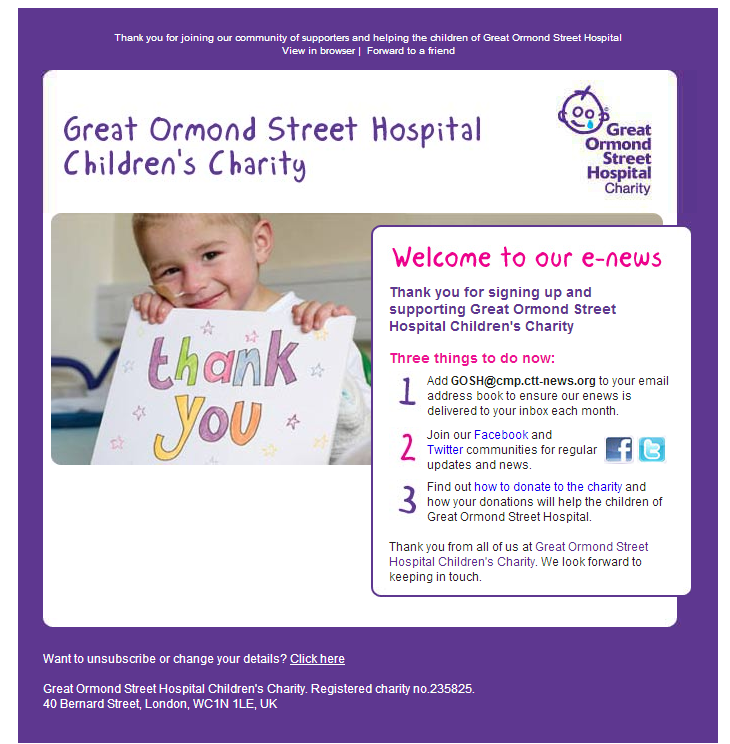
Now, one thing we don’t recommend doing in your welcome email is asking for donations. Soliciting donations straight off the bat might be too much, too fast, and may alienate subscribers.
For more examples and advice, make sure you read our guide on how to write a great welcome email for new subscribers.
2. Events
Events are always a fantastic way to raise awareness and donations for your cause. From charity auctions and 5K races to conferences and galas, every non-profit has its own staple of yearly events.
So, make sure your event is on your subscribers’ calendar with an email event invitation like this one from Amnesty International:

A successful email event invitation needs to be focused only on promoting that event alone, and nothing else. It should be short yet descriptive enough to convey your mission and the goals you’re looking to achieve with the event.
For those unable to attend your event, you could also offer an alternative way to donate online.
3. Regular newsletter
This is probably the most common type of email sent out by non-profits, and for good reason. Email newsletters are a fantastic way to not only keep your cause top of mind with donors, but also to keep them in the know about your organisation.
By being transparent and sharing information about what’s happening in your organisation, you’re also helping to build trust with potential donors. And when they trust you, they’re more likely to donate and to help your cause.
So, what should you write about in your newsletter? Here are a few ideas:
- Your non-profit in the news. Whenever your organisation gets mentioned in a news story or any reputable website or blog, link to it in your email to let subscribers know. This shows that your non-profit is getting recognised for your outstanding work.
- Website changes. If you’re redesigning your website, changing the donation process or adding new ways to contribute, your subscribers should be the first to learn about these changes.
- Organisational changes. Is there a new face on the board or in an executive position? Make sure to introduce this new important person to your subscribers in the form of a short bio or an interview.
When it comes to newsletters, regularity is key. So make sure to set a delivery schedule, maybe once a month, and stick to it so subscribers know when they can expect an email from you.
4. Educational content
If you want subscribers to feel compelled to support your cause, you need to educate them so they have all the facts and figures. This means sharing valuable information that they might find interesting and useful.
For example, if you’re an association supporting people with learning disabilities, you can share articles, videos and other resources on raising children with learning disabilities, practical solutions and the different groups to join to get support.
If your non-profit promotes a vegan or vegetarian lifestyle, you can educate subscribers on the benefits of being a vegan or a vegetarian, and even share special recipes that they might enjoy.
Here’s an example from Alzheimer’s Society:
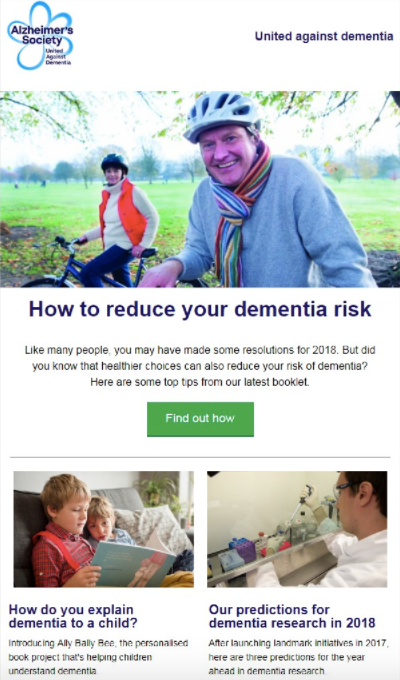
If you have the time and resources, you can write and publish this educational content on your own blog. If you don’t, you can always source it from established non-profit blogs.
Whether you write them yourself or link to external sources, make sure that the content you’re sharing is not only useful and interesting but also relevant to your audience.
5. Surveys
Just because an email isn’t asking for a donation, it doesn’t mean it isn’t asking subscribers for anything. Every email campaign you send out needs to have at least one call-to-action where you ask readers to take an action – whether it’s to read an article you’ve been featured in, to donate, to volunteer, to join an event or to share your cause with their friends and family.
Another action you can ask them to take is to fill out a survey. This survey can be about anything of interest to you – from feedback on your latest event or website redesign to suggestions on ways to improve the volunteering experience.
Check out these two examples:
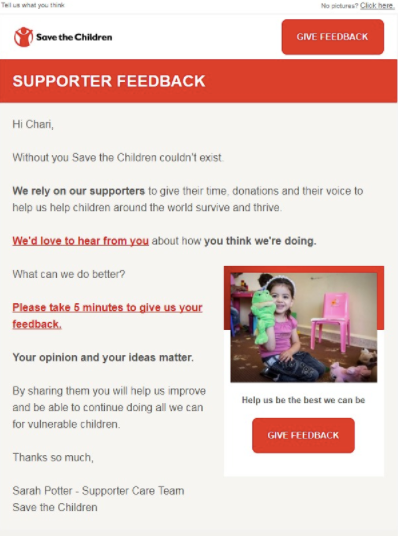
Feedback surveys are great tools that can help you to get valuable ideas for improving your efforts. In addition to receiving valuable feedback from donors and volunteers, you’re also letting responders know that you’re genuinely interested in what they have to say and that their opinions can also help make a difference.
6. Thank you
Depending on the email marketing service you’re using, you might already be sending automatic confirmation messages whenever a donor, sponsor or volunteer fills out a form or makes a donation.
These messages usually say “Thank you” so the recipient knows that their donation or registration to an event has been successful.
While these automated “Thank you” emails are necessary, they’re not the only instances when you should or could thank your subscribers. The end or beginning of the year, birthdays and holidays are great occasions to send donors and volunteers short messages to express your gratitude for taking the time, effort and money to involve themselves in your cause.
Here’s a great example from charity:water:
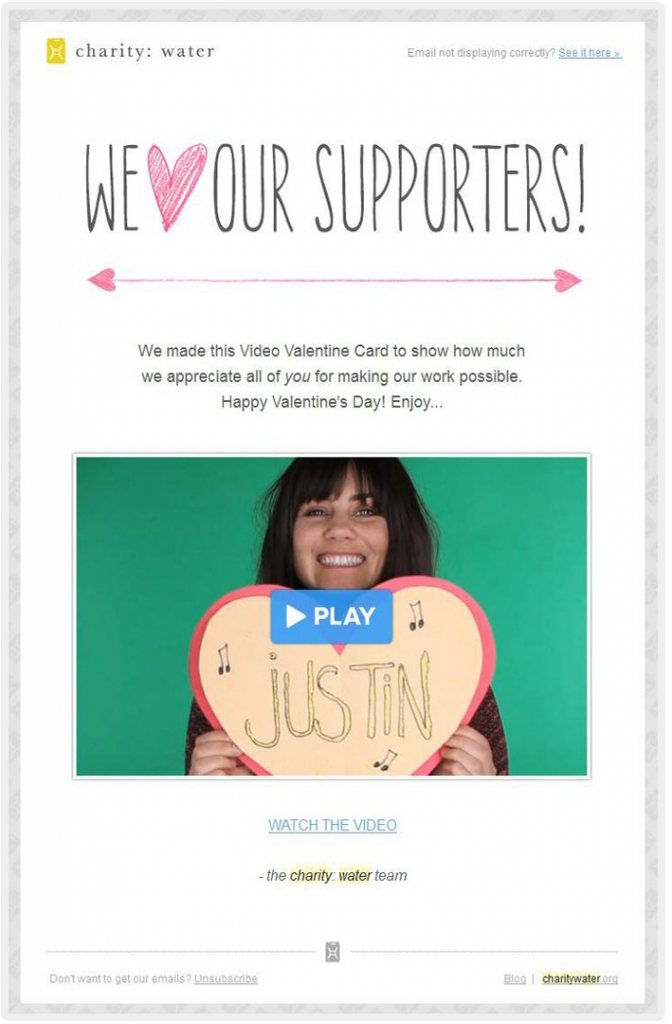
7. Success stories
An even better way to say “thank you” is to show your supporters how far you’ve made it together, and the impact that their contributions have made on the lives of people in need and the cause you champion.
The best way to do this is by telling a story. Nothing is more impactful that a descriptive story of donations at work. It’s how you can build a personal connection with donors, as well as potential donors.
For example, who won’t to feel a pull at the heart when they read the story of three-year-old Maryan from Kenya who has recovered from malnutrition?
By sharing success stories in your emails, you’re not only expressing your gratitude to donors and volunteers but you’re also showing how much your work matters and the difference your organisation is making in the world.
Lots of non-profits use numbers and stats to tell their success stories, so if you’ve got them, make sure to use them like in this example:
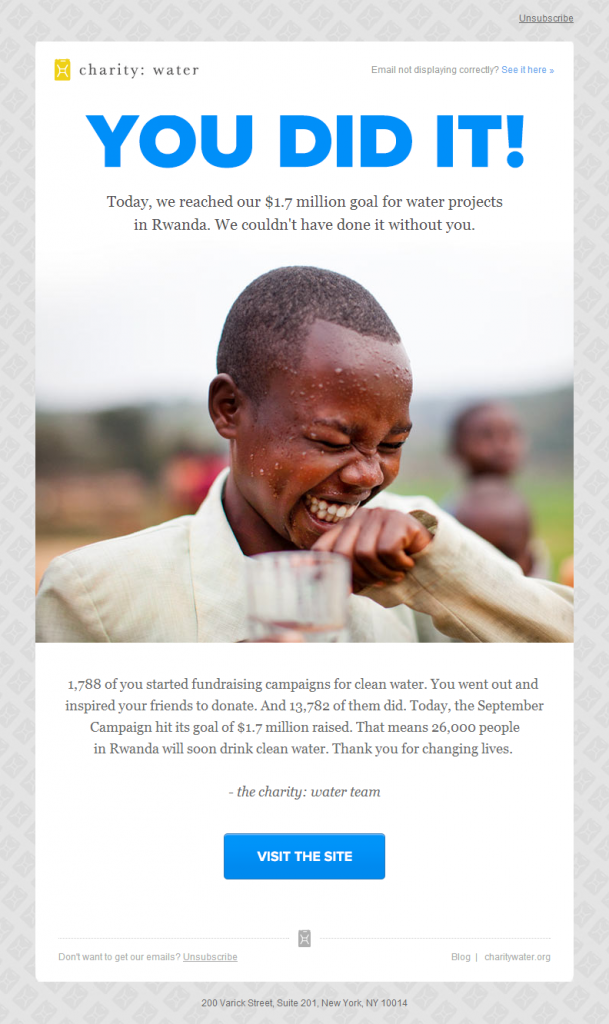
This type of emails can help you to achieve lots of things, including building trust with potential donors and encouraging them to take action.
Wrapping up
Sending a monthly generic message to all your subscribers and asking them to donate to your cause isn’t an effective email marketing strategy.
Just as your goals are diverse – from raising awareness and funds to spreading the word about your latest events as well as successes – so should your emails be. Hopefully the seven types of emails in this post will inspire you to rethink your strategy and make the most of email marketing.

